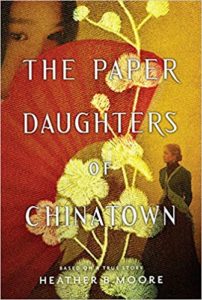Thanks to AML for inviting me to post about my book, The Paper Daughters of Chinatown. I’m not new to the world of writing historical fiction, but when I started researching the life of Donaldina Cameron (Dolly), I found that the topic would be quite extensive if I planned to include stories about the Chinese immigrant women she helped rescue from brothels and other servitude situations. I had to find a way to create a novel-like structure, though, which turned into covering the first thirteen years that Dolly worked at the Occidental Mission Home for Girls in San Francisco.
This book is based on the true story of Chinese immigrant women who came to America in the late 1800s. Because of the Chinese Exclusion Act that was signed by Congress, it was illegal for Chinese laborers to immigrate to America starting in 1882. As a workaround, criminal highbinders bribed Chinese women with money to their families, then provided false papers and false identities to get them into San Francisco. These women were promised that husbands or jobs were waiting for them. But when they arrived, they discovered they were about to be sold into slavery.
My book has two timelines. First, we meet Dolly Cameron—a real historical figure—who agrees to teach sewing classes at the mission home for one year. When the director and the Chinese interpreter ask Dolly to go with them on a rescue mission, she’s mortified when she sees the living conditions the “paper daughters” are confined to. Dolly becomes involved in more and more rescues as she and the staff at the mission bring the rescued girls and women to the mission home where they are provided a safe haven and an education. The small group of staff members at the mission home took it upon themselves to fight for the Chinese women’s rights while San Francisco authorities turned a blind eye and profit from the prostitution rings.
Alternating with the chapters on Dolly, we have the chapters of the young Chinese woman Mei Lien. Her character is a composite of true events lived through by other paper daughters. Mei Lien’s mother was given $400 dollars for allowing her daughter to go to America. Mei Lien was promised that a wealthy husband was waiting for her. She soon finds out that not only was she betrayed by the Chinese agent, but she is betrayed by a country that proclaims freedom for all.
While researching this novel, I was astounded how the mission home staff and the Chinatown Squad (a branch of San Francisco’s police force) would literally break down doors and rescue the Chinese girls and women. When more laws were put into place, both sides had to get lawyers, and the mission home had to get search warrants. In addition, Dolly would file for guardianship of the rescued slaves. In the mission home (funded by the Presbyterian Church), they also had Bible study classes. While the mission staff was inclusive and sensitive to the Chinese culture, they did have the girls attend these classes, memorize scripture, and learn Christian hymns. It was part of the history and what really happened, and whether we agree with this method, it had to be included in the story.
Also interesting and thought-provoking was that some of the girls who requested rescue couldn’t handle the sterilized mission home life and they returned to their addictions and abusive lives in the brothels. But if we understand the psychology of shame-based conditioning and the grip of trauma, then it becomes more understandable. Finally, the depth and breadth of corruption was surprising. At all levels, this human trafficking was supported by corrupt officials and city leaders. Dolly and the mission home staff had to figure out who to trust and who to rely on. This group of women banded together and stood up to depravity in their own city when everyone else ignored it.
Remarkably, the mission home still operates today in San Francisco. It has been renamed The Cameron House after Dolly Cameron who spent her entire career serving there. The place offers community services, counseling, and youth group activities.
Unfortunately, for all the work that Dolly Cameron and other women like her did, human trafficking still exists in all forms. It hasn’t been eradicated. In this book, I focused on the few women Dolly did help. I highlighted their stories of healing and triumphs. Yes, there were still lost women and girls, those who suffered tremendously, only to have their lives cut short, but I clung to the women who made it through. They were my inspiration, and they became my hope. I learned that even one step up that mountain was one step that hadn’t been taken before. Maybe she didn’t conquer all, but the journey and the progress of Dolly’s work was valuable, and in some cases, literally life-saving.
 Heather B. Moore is a four-time USA Today bestseller and award-winning author of more than seventy publications. Heather graduated from Brigham Young University with a major in Fashion Merchandising and minor in Business Management–which has absolutely nothing to do with writing novels. But at least she can balance a mean checkbook and color-coordinate her kids’ school clothes.
Heather B. Moore is a four-time USA Today bestseller and award-winning author of more than seventy publications. Heather graduated from Brigham Young University with a major in Fashion Merchandising and minor in Business Management–which has absolutely nothing to do with writing novels. But at least she can balance a mean checkbook and color-coordinate her kids’ school clothes.
Heather writes historical novels and thrillers under H.B. Moore. She also writes women’s fiction, romance, and inspirational non-fiction under Heather B. Moore, including the Pine Valley series, The Newport Ladies Book Club, and the Amazon bestselling Timeless Romance Anthologies. Heather’s USA Today bestselling titles include Heart of the Ocean, Mail Order Bride, Mistress Grim, and Poetic Justice. Heather also writes Young Adult speculative under pen name Jane Redd, which includes the Solstice series. Foreign publications include Das Grab der Konigin (Germany), Drommen om lykke (Norway), and Sommer og kjaerlighet (Norway).

